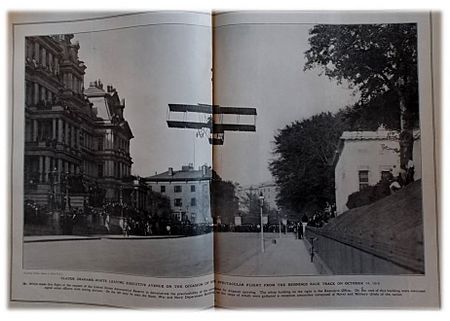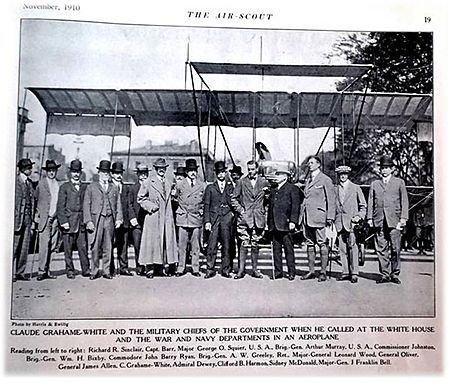United States Aeronautical Reserve facts for kids
The United States Aeronautical Reserve (U.S.A.R.) was an early group focused on aviation. It was started by the Aero Club of Harvard University on September 8, 1910. John H. Ryan founded the group, and Richard R. Sinclair was its General Secretary.
Many famous early aviators and important people joined U.S.A.R. when it began. Some of these included Glen H. Curtiss, Wilbur Wright, and Harry S. Harkness. Other notable members were Augustus Post, Clifford B. Harmon, and Allan R. Ryan. Recruiting offices were set up at Harvard University in Boston, Massachusetts. There were also offices in Mineola, Long Island, and Belmont Park, Long Island. Belmont Park is famous for its racetrack, but it also played a big part in early aviation.
The U.S.A.R. had a General Board with key leaders. Clifford Harmon was the Chief of Staff. John Barry Ryan was the Commodore. Other members included Herbert I. Satterlee and Cortland Field Bishop from New York. Wilbur Wright from Dayton, Ohio and Glenn Curtiss from Hammondsport, NY, were also on the board. Important political figures like Hon. John F. Fitzgerald from Boston, MA, joined too. Charles H. Allen was the Treasurer, and Richard R. Sinclair was the Assistant Treasurer.
The U.S.A.R. worked with military leaders. Brigadier General James Allen from the Army's Aeronautical Division, U.S. Signal Corps was a contact. Captain W. Irving Chambers from the Navy also worked with them. Major General Leonard Wood, the Army's Chief of Staff, was a U.S.A.R. member. By November 1910, the U.S.A.R. had 3,200 members. Even U.S. President William Howard Taft was a member.
Contents
U.S.A.R. Recognized by Military Departments
The United States Aeronautical Reserve received official recognition. Both the United States Department of War and the United States Department of the Navy supported it. The group was set up like a military organization. Its goal was to improve aviation for national defense. They wanted to make sure people did not confuse U.S.A.R. with other aviation clubs.
Target Practice Bombing Contest
In 1910, U.S.A.R. founder John H. Ryan started a competition. It was called the Commodore John Barry International Target Practice Cup. The Aeronautical Society helped organize it. Ryan offered a $10,000 prize for a "bomb throwing" contest from an airplane. The trophy was a bronze statue of "Commodore Barry," the first Commodore in the American Navy.
The Washington Post reported on the contest in October 1910. Clifford Harmon and Grahame-White shared the prize. John H. Ryan also had a bold plan in 1910. He wanted to build an airplane landing strip on the roof of U.S.A.R.'s main office. This office was at 53rd Fifth Avenue in Manhattan, New York City. Ryan thought he could combine several rooftops. This would create a landing strip about 250 feet long and 17 feet wide.
The Air-Scout: U.S.A.R.'s Official Magazine
In 1910, the U.S.A.R. General Board started its own magazine. It was a monthly publication called The Air-Scout. Later, this magazine joined with Town & Country magazine.
The Air-Scout was a fancy, glossy magazine. It was quite large, about 14 inches long and 17 inches wide. It shared news about aviation in the U.S. and other countries. The magazine also had social pages. These pages featured wealthy people who supported airplanes. It included names like Mr. and Mrs. Cornelius Vanderbilt. There was also a page for women aviators. Baroness Raymond de La Roche of France was mentioned as the first woman to get a pilot's license.
The magazine covered news on wireless technology and airships. It also reported on airplane contests and military aviation. It showed where the U.S.A.R. might be needed. There were many photos from war reporters and professional photographers. Many writers for the magazine were U.S.A.R. members. Harry M. Horton, known for creating early long-distance wireless equipment for airplanes, was one of them. The publication also featured many advertisements.
Participating in Airplane Shows
In 1911, the First International Industrial Airplane Show took place. It happened alongside the 11th U.S. International Auto Show. Both events were held at Manhattan’s Grand Central Palace in New York City. The Aero Club of New York created the aviation show. It had the largest attendance ever recorded at the Palace back then.
The United States Aeronautical Reserve had a special booth at the show. They displayed interesting airplanes. On January 5, 1911, they showed early wireless communication technology. They used a "Wilcox aeroplane" with Horton's wireless device. This device was used to talk from the airplane to news reporters on the ground. It also tested how far it could communicate with steamships at sea. The Aeronautical Society and U.S.A.R. displayed their full-size airplanes. These were in the second gallery of the Grand Central Palace. Charles W. Chappelle, a U.S.A.R. member, showed his own full-size airplane. He won a medal for being the only African-American to invent and display an airplane.
Military Airplane Display in Washington, D.C.

Both the Boston Daily Globe and U.S.A.R.'s The Air-Scout reported on Grahame-White's flight. In October 1910, he landed an airplane near the War Office in Washington, D.C. This was a demonstration of distance and speed. The U.S.A.R. asked Grahame-White to perform this test. Hundreds of military personnel watched him. He successfully landed his airplane on a narrow street. It took only a few minutes from a good distance.
The Boston Daily Globe said he landed "within 10 minutes." He landed "between the White House and the war department." General Leonard Wood was there, and President Taft's office window was nearby. General Nelson A. Miles believed airplanes could destroy entire fleets. He thought they could drop bombs on ships' decks or engine rooms. Major General Leonard Wood also spoke. He believed airplane technology would greatly improve in the future.
First Military Use of a U.S.A.R. Airplane
The U.S.A.R. hoped the U.S. military would use many of their airplanes. The military did use at least one U.S.A.R. airplane. This was for a peacekeeping mission. Two U.S.A.R. members were involved. The Air-Scout's March 1911 issue reported this:
On February 16, 1911, the U.S. Army accepted Mr. Collier’s biplane. The U.S.A.R. had offered it. On the same day, Major General Leonard Wood announced the plane would go to the Mexican border. The next day, an airplane was ordered to a battle area for the first time ever. Its job was to patrol the Mexican border. This was to help keep neutrality laws. Lieutenant Foulios, a trained U.S. Army aviator, was ordered to serve on the airplane. Phillip O. Parmalee, a Wright aviator and U.S.A.R. lieutenant, volunteered his help. His offer was accepted. He was also ordered to go to Texas. The Air-Scout published photos of this event.


